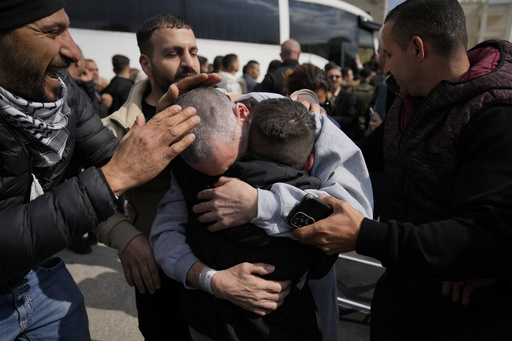KHAN YOUNIS, Gaza Strip — On Saturday, Hamas militants released three male hostages who had been held for over a year in the Gaza Strip, while Israel reciprocated by freeing 183 Palestinian prisoners from its jails. This exchange is part of an ongoing ceasefire agreement that has brought a pause to 15 months of brutal conflict between the two sides.
The hostages—Yarden Bibas and French-Israeli Ofer Kalderon—were handed to Red Cross representatives in Khan Younis, a southern city in Gaza. American-Israeli hostage Keith Siegel, appearing weak and pale, was also transferred to the Red Cross in Gaza City later that morning. All three men were taken captive during a Hamas-led assault on Israel on October 7, 2023, which marked the start of the conflict. This latest release brings the total number of hostages freed since the ceasefire commenced on January 19 to 18.
The procedure for the releases was orderly, in stark contrast to the chaotic scenes witnessed on Thursday when armed militants struggled to control crowds during another release. On Saturday, masked and armed members of Hamas stood beside a stage as the hostages walked out and waved to the crowds before being taken to the Red Cross. Thousands gathered in Tel Aviv’s Hostages Square to watch the emotional scene unfold on large screens, holding up signs and applauding.
After Siegel’s arrival in Israel, a bus carrying about 32 Palestinian prisoners left Ofer Military Prison bound for the West Bank. Welcoming crowds greeted the bus with cheers, lifting some of the released individuals onto their shoulders in celebration. The Israeli Prison Authority confirmed that all 183 Palestinian prisoners due for release on Saturday had been freed. The majority, specifically 111, were apprehended following Hamas’ October 7 attack and were predominantly sent to Gaza, while about two dozen returned to the occupied West Bank. Additionally, seven prisoners serving life sentences were transferred to Egypt ahead of their deportation.
This ceasefire is hoped to address the devastating conflict between Israel and Hamas, which has been the most deadly in history. It has lasted two weeks, allowing critical aid to reach the Gaza Strip as hundreds of thousands of displaced Palestinians have begun returning to what remains of their homes in the north.
During the initial phase of this six-week ceasefire, 33 Israeli hostages are expected to be released in exchange for approximately 2,000 Palestinian prisoners. While Israel claims to have received reports from Hamas regarding the fates of eight hostages—stating they were either killed during the initial assault or have died in captivity—other efforts continue.
On the same day, a group of 50 sick and injured Palestinian children was allowed to leave Gaza for medical treatment, crossing the Rafah border into Egypt. This marked the first opening of Gaza’s only exit point since Israel took control of the region nine months earlier. A European Union mission had been deployed in advance to facilitate this reopening.
Plans for a second phase of the ceasefire, involving discussions on the release of remaining hostages and prolonging the truce indefinitely, are set to commence next week. Should a resolution not be reached, the conflict could potentially reignite in early March. Israel maintains its determination to dismantle Hamas, even as the militant group has quickly shown signs of re-establishing its influence in Gaza following the latest temporary halt in hostilities. A significant far-right ally in Netanyahu’s coalition government is advocating for a return to military action following this phase of the ceasefire.
Hamas has expressed that it would not release any remaining hostages unless the war ends and Israel fully withdraws from Gaza.
The family of Keith Siegel, 65, who was originally taken hostage from Kibbutz Kfar Aza alongside his wife, Aviva, shared their joy at his release. His wife was freed during an earlier ceasefire and has since been vocal in campaigning for the release of other hostages, including her husband.
In a residence where Kibbutz members gathered to witness the release, there were emotional expressions of relief and joy as they watched Siegel make his way back home. Conversely, the release of Yarden Bibas, 35, renewed concerns for his wife and children, who were abducted alongside him. His youngest son, Kfir, who was just nine months old at the time of the kidnapping, has become emblematic of the despair surrounding the hostage situation in Israel.
Hamas has stated that Bibas’s family members died due to an Israeli airstrike, a claim that has not been verified by Israel. Gal Hirsch, the Israeli Prime Minister’s lead on hostage affairs, expressed serious concerns for Shiri and her children’s safety and requested updates from negotiators on their status.
Ofer Kalderon, 54, was also taken captive from Kibbutz Nir Oz. His family in Kfar Saba rejoiced when they saw images of him being released, calling out in celebration. Kalderon’s children had already been freed earlier, and family members emphasized the healing that would begin upon his return.
French President Emmanuel Macron expressed France’s solidarity and joy at Kalderon’s return after a distressing 483 days of captivity, vowing to continue efforts to secure the release of another French-Israeli hostage still held by Hamas.
Over 100 hostages taken during the October 7 assault have been freed during a previous ceasefire, but approximately 80 remain in Gaza, with many believed to be deceased. The conflict had claimed around 1,200 lives in Israel, mostly civilians, whereas Gaza’s Health Ministry reported over 47,000 Palestinian dead as a result of Israel’s military actions—of which more than half were women and children. The Israeli military claims that over 17,000 militants were killed in the conflict without supplying evidence and attributes the civilian casualties to Hamas, stating that fighters commonly operate in residential areas.
